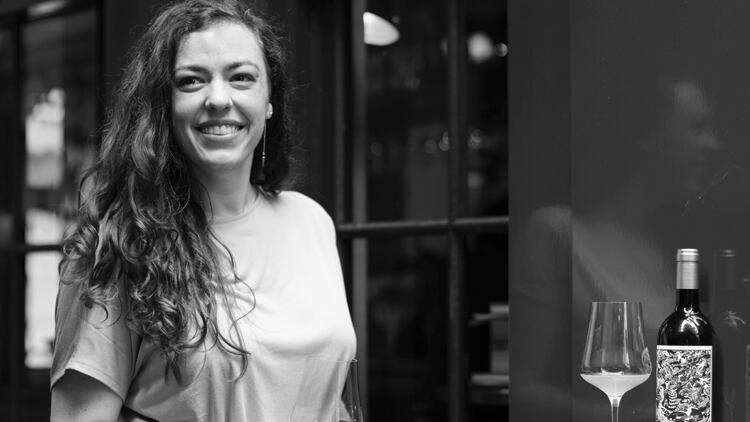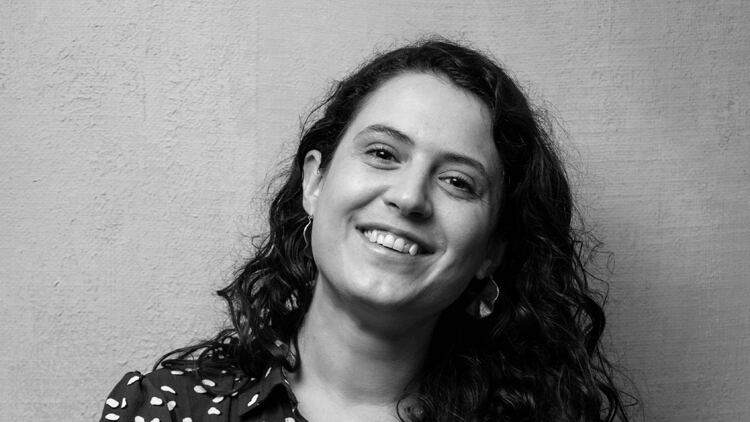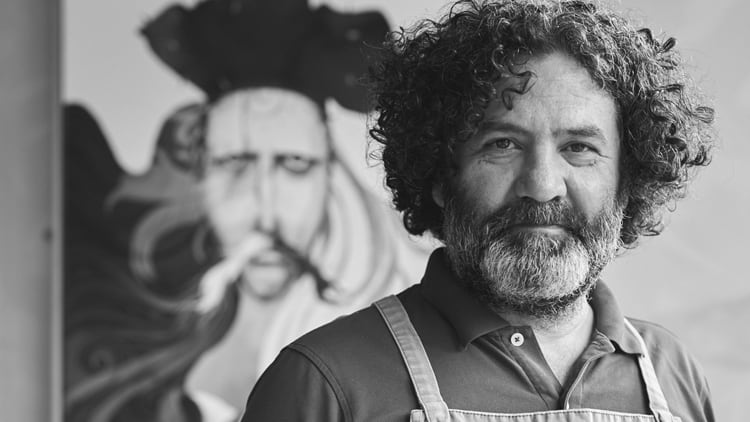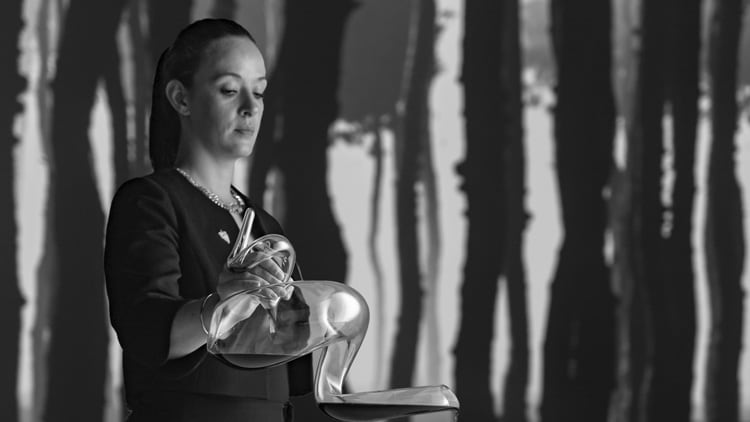Tell us about the moment you first became interested in wine...
I was freshly 21 years old, visiting my aunt and uncle in El Dorado, California, for Thanksgiving. We went on a wine tour that started at Bella Piazza Winery, which produces wines from some of the ‘lesser-known’ Italian varieties. I had a lightning-struck moment when I tasted their Barbera and immediately noticed a blackberry and violet aroma — it was the first time I remember enjoying the nuance of flavour and aroma and texture without the presence of sweetness in a drink. At that point, I was hooked.
Tell us about your wine list at The Mulwray.
The Mulwray list is constantly evolving; I collaborate with Honey, the group’s wine director, to bring in organic, biodynamic, natural, and sustainable wines that run the gamut from classic representations from ‘traditional’ regions to explosively off-piste wines from unexpected places. The list is presented as a spectrum from the more classic Firm Favourites to the Wild + Free, allowing guests to decide how adventurous they want to be during their visit. We work with a lot of suppliers, and our flexibility with the 100-120 bins is fairly unlimited; as The Mulwray serves wine-friendly bar snacks, we’re motivated to find wines that shine without the influence of food-pairing. At the same time, we partner with the Evelyn’s Table chefs to find exciting wines to pair with their seasonal ingredients and subtle textures and flavours.
Over the course of your career, have you had any wine-related disasters? eg. dropping an expensive bottle/ordering a case of oxidised Burgundy etc.
I’ve definitely had a few slips while serving wine, missing a guest’s glass when pouring or toppling over a bottle, but I hope that when I make a mistake, I’ve built enough understanding and connection with my guests that we can all laugh it off and move forward together. If we can do that, I find that mistakes are quickly forgotten.
Name your top three restaurant wine lists (excluding your own!)
Top three is really tough. I’m absolutely biased when I name The 10 Cases, but the constraint of only ever buying 120 bottles of any wine means that they never have the same list twice — I can always discover something new. I love the wine list at Perilla, headed up by the legendary Juste Karbauskaite, and the NoMad Hotel list put together by Amber Gardner and her team. There are so many incredible lists in London alone that I feel like I could never get to them all!
Who do you most respect in the wine world?
Juste, at Perilla, and Amber, at NoMad, are absolute rockstars of hospitality and wine knowledge. I’m also lucky to work with Honey Spencer, who I swear has seven lifetimes’ worth of experiences and stories to share, Emma Denney, at Davies and Brook, Monique Ziervogel at Spring, Jac Smith at Bottles n Jars—all these incredible sommeliers are so inspirational, and I’m constantly learning so much and having the absolute time of my life when we’re together.Bianca Bosker, whose hilarious writing in Cork Dork re-ignited my love for wine when I was considering other careers; Jancis Robinson, who is a titan and a legend in wine writing, and Dan Keeling and Mark Andrew of Noble Rot, whose magazine I tear through the second it arrives.
What’s the most interesting wine you’ve ever come across?
Cerdon La Cueille sparkling Gamay/Poulsard rosé from Domaine Bottex in Bugey is a wine that is made of delight. Its fermentation was arrested, so it’s only 8% alcohol, sparkling, medium-sweet, and gloriously magenta-coloured. But the wine’s texture and acidity are so focused and balanced, and the tension between the accessibility of the sweetness and bubbles and the structure of the liquid makes it such an intriguing, more-ish wine to drink. I often say this is the wine 33-year-old-me and 14-year-old-me would agree on. I get so excited to share this wine with guests, because it’s not a wine for rumination; it’s a wine for joy.
What are the three most overused tasting notes?
Fruity, fresh and earthy. They’re good jumping-off points for going deeper into the wine, but the terms themselves are so broad as to become meaningless. What kind of fruit? Is it ripe? Cooked? Dried? Is it fresh because it’s young, or has high acidity, or a bit of CO2? Does earthy refer to a wine that has significant bottle age, or is it a rustic tannin sensation, or the nature of the grape, or maybe the expression of the wine’s terroir?
What’s the best value wine on your list at the moment (and why)…
We have a book of blink-and-you-might-miss-it wines, with only a small cash margin added to their cost price. There may or may not be (but definitely is) a 2015 Morey-Saint-Denis from Domaine Dujac listed for less than average retail price. That’s an epic find for someone who wants to splash out on a bottle.
What is your ultimate food and drink match?
In Evelyn’s Table, we currently have a tempura shiso leaf, mussel, and tomato taco; it’s kind of a challenging dish to pair, with the fresh acidity of the tomatoes, the lightly salty tempura leaf, and the chewy, delicate flavour of the mussels. We pair it with Susumante, this insanely delicious — but not overpowering — sparkling rosé of Susumaniello, an indigenous Puglian grape, from L’Archetipo. It’s such an exciting pairing, and I love that we get to showcase such a cool, unusual wine with such a showstopper of a dish.
Old World or New World?
I’d rather abandon the concept entirely. We can talk about traditions, approaches to winemaking, and regional history until we’re blue in the face, but with the ever-expanding global wine trade, Old World and New World are just monikers that make no sense. What is Georgia, if not an Old wine-making region?
What is your pet hate when it comes to wine service in other restaurants?
I dislike it when I can tell that a wine list has gone unchanged for years but the servers have not been trained on the wines they sell. I don’t expect most wine lists to change as often as ours, but if the list is laminated, the staff should be well-informed and able to comfortably take guests through the list.
Who is your favourite producer at the moment and why?
I have to go to Champagne for this one; I love my grower bubbles, especially from Agrapart, Prévost, and Ulysses Collin. But having recently cracked a bottle of his L’Apotre, I have to say that David Léclapart has earned a top spot from me.
As a sommelier, what question do you most get asked by customers?
What’s your favourite wine? is quite common; it’s understandable, especially if a guest is just starting to dive into the wine world, but it’s a tough question to answer.
Which wine producing region/country is currently underrated at the moment and why?
I love the Finger Lakes wines in New York, especially seeing the finesse with which they are producing Cabernet Franc, Riesling, and traditional method sparkling. I’m also a big fan of Austrian varieties, and I’d love to see their potential in emerging still-wine regions like the north of England and Sweden.
It’s your last meal and you can have a bottle of any wine in the world. What is it and why?
There’s a bottle of 2003 Ch. Haut-Brion that my now-husband gave to me for our first anniversary when we were dating. We haven’t cracked it open yet, and there’s no one else I’d drink it with. Since we didn’t drink it to celebrate our engagement (that was a Maison Harbour Bourgogne) nor for our wedding (where we drank G.D.Vajra Albe Nebbiolo), I suppose my last meal would be a good time to finally share that bottle.





